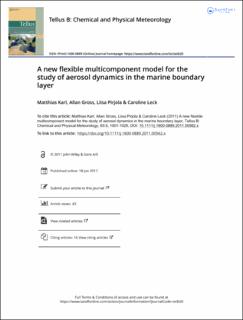| dc.contributor.author | Karl, Matthias | |
| dc.contributor.author | Gross, A. | |
| dc.contributor.author | Pirjola, L. | |
| dc.contributor.author | Leck, C. | |
| dc.date.accessioned | 2020-04-14T13:10:42Z | |
| dc.date.available | 2020-04-14T13:10:42Z | |
| dc.date.created | 2011-12-29T20:07:31Z | |
| dc.date.issued | 2011 | |
| dc.identifier.citation | Tellus. Series B, Chemical and physical meteorology. 2011, 63 (5), 1001-1025. | en_US |
| dc.identifier.issn | 0280-6509 | |
| dc.identifier.uri | https://hdl.handle.net/11250/2651030 | |
| dc.description.abstract | A new sectional aerosol dynamics model, MAFOR, was developed with the focus to study nucleation in the marine boundary layer. Novel aspects of the model are (1) flexibility in the treatment of gas phase chemistry, (2) treatment of liquid phase chemistry, which can be extended according to needs and (3) simultaneous calculation of number and mass concentration distributions of a multicomponent aerosol as functions of time. Comparison with well-documented aerosol models (MONO32 and AEROFOR), a comprehensive data set on gas phase compounds, aerosol size distribution and chemical composition obtained during theA OE-96 (Arctic Ocean Expedition, 1996)was used to evaluate the model. Dimethyl sulphide decay during advection of an air parcel over the Arctic pack ice was well captured by the applied models and predicted concentrations of gaseous sulphuric acid and methane sulphonic acid range up to 1.0 × 106 cm−3 and 1.8 × 106 cm−3, respectively. Different nucleation schemes were implemented in MAFOR which allow the simulation of new particle formation. Modelled nucleation rates from sulphuric acid nucleation via cluster activation were up to 0.21 cm−3 s−1 while those from ion-mediated nucleationwere below 10−2 cm−3 s−1. Classical homogeneous binary and ternary nucleation theories failed to predict nucleation over the central Arctic Ocean in summer. | en_US |
| dc.language.iso | eng | en_US |
| dc.rights | Navngivelse 4.0 Internasjonal | * |
| dc.rights.uri | http://creativecommons.org/licenses/by/4.0/deed.no | * |
| dc.title | A new flexible multicomponent model for the study of aerosol dynamics in the marine boundary layer | en_US |
| dc.type | Peer reviewed | en_US |
| dc.type | Journal article | en_US |
| dc.description.version | publishedVersion | en_US |
| dc.rights.holder | © 2011 John Wiley & Sons | en_US |
| dc.source.pagenumber | 1001-1025 | en_US |
| dc.source.volume | 63 | en_US |
| dc.source.journal | Tellus. Series B, Chemical and physical meteorology | en_US |
| dc.source.issue | 5 | en_US |
| dc.identifier.doi | 10.1111/j.1600-0889.2011.00562.x | |
| dc.identifier.cristin | 873761 | |
| cristin.ispublished | true | |
| cristin.fulltext | original | |
| cristin.qualitycode | 1 | |

